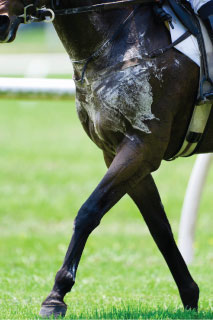ARCHIVE EQUINE NEWS STORIES
| Current news is available at TheHorsePortal.ca, Equine Guelph's online learning platform for practical, quick learning. Given the vast amount of information on horse health and welfare, Equine Guelph has archived its past news articles from 2002-2020. They are listed below, along with a search function available to find specific healthcare topics. | |
Eye Opener for Electrolyte UseJuly 2013
By – Jackie Bellamy
 Most horse owners have used a skin pinch test to assess hydration in a horse. University of Guelph professor, Dr. Mike Lindinger cautions this qualitative approach can not only give a false negative but may also be too-little-too-late as clinical dehydration may already be occurring at the point when skin tenting is apparent.
Most horse owners have used a skin pinch test to assess hydration in a horse. University of Guelph professor, Dr. Mike Lindinger cautions this qualitative approach can not only give a false negative but may also be too-little-too-late as clinical dehydration may already be occurring at the point when skin tenting is apparent.
Lindinger first became involved with studying electrolyte balance in horses 20 years ago after meeting potential M.Sc. student Gayle Ecker, current director of Equine Guelph. Ecker introduced Lindinger to elite equine athletes in the world of endurance riding and eventing. Riders know first-hand the damaging effects that can result from dehydration, a condition when sweating exceeds drinking. However, the amount of salt a horse loses in sweat is far greater than their human counterparts. Horses can lose up to 10 – 15 litres of water an hour. Lindinger explains, “Drinking plenty of water after exercise is NOT enough!” Prolonged exercise results in loss of electrolytes and depleted glycogen levels which contribute to muscle soreness and poor performance. When there is dehydration consequences can be as serious as lack of appetite, colic, physical injury, heat strain, hyperthermia, cardiovascular impairment and kidney damage.
Simply replacing water is not sufficient due to the high concentration of electrolytes that a horse loses during sweating (including sodium, potassium, chloride, magnesium and calcium). Water given during or after exercise dilutes the body fluid compartments and is excreted because the body senses it as volume overload. Giving electrolytes again after exercise helps restore those essential nutrients lost during sweating.
Lindinger and Ecker, with the help of Buckeye Nutrition, have produced the only scientifically developed and tested electrolyte supplement. Their study monitored the performance of horses on a treadmill with and without use of the electrolyte supplement. They showed that when horses received electrolyte supplement one hour before exercise the horses could perform at a fast trot for 27% longer duration than the control group. The research also measured the rate of gastric emptying and intestinal absorption into the blood. Gamma camera imaging was used to track gastric emptying and showed the electrolyte supplement emptied from the stomach as quickly as water. Through blood testing it was discovered the supplement, given one hour prior to exercise, was being absorbed into the blood within 10 minutes of administration. Muscle biopsies showed that potassium was taken up by this tissue, and sweat analysis showed appearance of sodium from the supplement, indicating that supplemented electrolytes replace those lost through sweating. Electrolytes moderate many body functions including firing of nerves and contracting of muscles.
Lindinger’s studies have included working with three-day event horses and endurance horses (most notably before the games in Atlanta) but high performance horses are not the only ones at risk for dehydration. Transport stress can also result in dehydration. Lindinger says one of the first signs of dehydration is usually behavioural, as the horse becomes less responsive. His studies conclude that giving electrolytes before situations likely to cause dehydration will be beneficial to overall performance and help guard against the serious effects of dehydration. Funding for Mike Lindinger’s research has been provided by the American Endurance Rider’s Conference, Buckeye Nutrition, Equine Guelph, Natural Sciences and Engineering Research Council of Canada, Ontario Ministry of Agriculture, Food and Rural Affairs and United States Equestrian Federation Equine Health Research Fund.